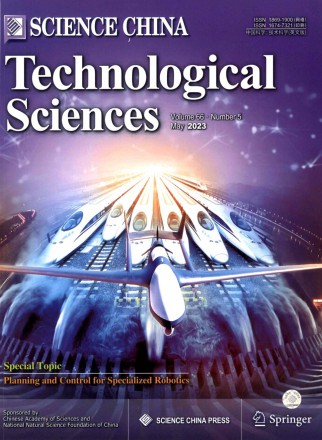
《Science China Technological Sciences期刊》CSCD期刊 統計源期刊 SCI期刊
Science China Technological Sciences《Science China Technological Sciences》雜志是CSCD期刊統計源期刊、SCI期刊、,創辦于1996年,發行周期是月刊。綜合影響因子0.45,中國科學院主辦,中國科學院主管。主要欄目有材料科學、機械工程、工程熱物理、水利、空間科學、航空、土木工程、核科學與技術、電工、建筑、工程力學等。
-
主管單位:中國科學院
-
ISSN:1674-7321
-
主辦單位:中國科學院
-
CN:11-5845/TH
-
審核時間:1-3個月
-
創刊時間:1996
-
全年訂價: ¥ 2712.00
-
發行周期:月刊
雜志簡介
《Science China Technological Sciences》是中國科學院主辦、中國科學雜志社出版的自然科學專業性學術刊物。任務是反映中國自然科學各學科中的最新科研成果,以促進國內外的學術交流。
《Science China Technological Sciences》以論文形式報道中國基礎研究和應用研究方面具有創造性的、高水平的和有重要意義的科研成果。 在國際學術界,《中國科學》作為代表中國最高水平的學術刊物也受到高度重視。國際上最具有權威的檢索刊物SCI,多年來一直收錄《中國科學》的論文。1999年《中國科學》奪得國家期刊獎的第一名。
期刊須知
Manuscript format
Contributions are required of a concise, focused account of the findings and reliable essential data. They should be well organized and written clearly and simply, avoiding exhaustive tables and figures. Authors are advised to use internationally agreed nomenclature, express all measurements in SI units, and quote all the relevant references.
Title: Titles must be limited to no more than 20 words, and should be concise, indexable, and informative for a broad scientific audience. Authors should avoid using colons, questions, nonstandard abbreviations, etc., in titles.
Author(s): Authorship should be limited to those who have contributed substantially to the work.
The order of the authors listed should be agreed by all the coauthors, and every author should have the responsibility for the published content.
Family names are written in upper case. The email address of the corresponding author is required.
Author affiliation: The affiliation should be the institution where the work was done. Complete addresses are required with post codes.
Abstract: An abstract is a summary of the content of the manuscript. It should briefly describe the research purpose, method, result and conclusion. The extremely professional terms, special signals, figures, tables, chemical structural formula, and equations should be avoided here, and citation of references is not allowed.
Keywords: A list of three to eight keywords should follow the abstract. The chosen keywords are required to reflect the theme of a manuscript.
Financial support: Financial support appears on the bottom of the title page, with grant number(s) following. The full title of each fund is required. For example: National Natural Science Foundation of China; National High-Tech Research & Development Program of China; National Basic Research Program of China.
Text: A paper should begin with a brief introduction of the significance of the author’s research. Nomenclature, signal, and abbreviation should be defined at their initial appearance. All the figures and tables should be numbered in numerical order.
Introduction: Being the most important part of an article, the introduction introduces the relevant research background and the progress in 2 or 3 years, with references cited in numerical order, then presents the problem to be solved in this article, and finally briefly describes the method adopted in this work. Before the end, the aim of the research should be mentioned. Subtitle is forbidden in this part, and introduction of the article structure is considered unnecessary.
Materials and method: This part introduces the materials, method and experimental procedure of the author’s work, so as to allow others to repeat the work published based on this clear description.
Discussion and conclusions: Conclusions should be derived from the observation and experimental results, and comparison with other relevant results is considered helpful to further proving the results. Repeated data should be
avoided, and conclusions and suggestions are required to be clearly expressed. New hypotheses and recommendations may be proposed when warranted.
Figures and tables: Figures and tables should be numerically numbered, inserted in the text, and cited in order within the text. The figures should have resolution not lower than 600 dpi and clear lines of 5 px, with signals and letters in Times New Roman at8 pt. A space should always be maintained between the variable and the unit.
Equations: An equation is numerically numbered (Arabic numeral), and has the number put on its right side.
Acknowledgements: The author expresses his/her thanks to the people helping with this work, and acknowledges the valuable suggestions from the peer reviewers.
References: Reference citation is regarded as an important indicator of the paper quality. If the relevant references, especially the results published in 2 to 3 years are not cited in the paper, or most citations are from the author’s publications, the editor will consider this paper unattractive. References should be numerically numbered and cited in order within the text, with the numbers expressed in square brackets. The author should carefully check the author names, article title, journal title, year, volume and issue number of references, and create the listing according to the format of Sci China Ser E-Tech Sci.
Reference format
1. For an author’s name, full spelling of family name appears before abbreviation of given name, with a spacing in the middle.
2. If there are more than 3 authors, the first 3 names are followed by et al.
3. The article title should be identified by an initial capital letter with the remainder of the title in lower case.
4. For correct abbreviations of journal titles, refer to ISO, e.g., Chin Sci Bull for Chinese Science Bulletin, Sci China Ser C-Life Sci for Science in China Series C-Life Sciences.
5. For books and proceedings, the initial letter is capitalized for all the notional words and for function words with more than 4 letters.
6. Do not forget to list the editor names of the proceedings, the publisher, the publishing address, and the beginning and terminating pages.
7. Accepted but unpublished papers should be followed by “in press”.
8. Websites or homepages cannot be cited as references.
期刊收錄
期刊榮譽
數據分析
- 綜合影響因子:1.3
- 期刊他引率:暫無
- 被引半衰期:暫無
- 平均引文率:暫無
立即指數
期刊他引率
立即指數:表征期刊即時反應速率的指標,即該期刊在評價當年刊載的論文,每篇被引用的平均次數。
期刊他引率:期刊被他刊引用的次數占該刊總被 引次數的比例用以測度某期刊學術交流的廣度、專業面的寬窄以及學科的交叉程度。
影響因子:指該刊在某年被全部源刊物引證該刊前兩年發表論文的次數,與該刊前兩年所發表的全部源論文數之比。
影響因子
雜志發文量
主要發文機構分析
| 機構名稱 | 發文量 | 主要研究主題 |
| - | - | - |
相關雜志
-
Journal of Thermal Sci...
主管單位:中國科學院
-
Journal of Wuhan Unive...
主管單位:國家教育部
-
Journal of Systems Sci...
主管單位:中國科學技術協會
-
Nuclear Science and Te...
主管單位:中國科學院
-
Science China Mathemat...
主管單位:中國科學院
-
Journal of Computer Sc...
主管單位:中國科學院
-
Science China Earth Sc...
主管單位:中國科學院
-
Journal of Materials S...
主管單位:中國科協
-
Plasma Science and Tec...
主管單位:中國科學院;中國科協
-
Chinese Journal of Pol...
主管單位:中國科學技術協會
-
International Journal ...
主管單位:中華人民共和國教育部
-
International Journal ...
主管單位:中華人民共和國教育部
免責聲明
若用戶需要出版服務,請聯系出版商,地址:北京東黃城根北街16號,郵編:100717。